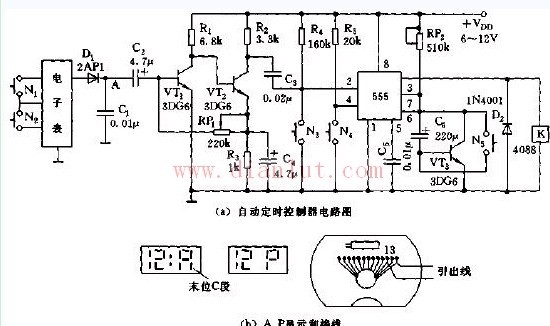As shown in the figure is an automatic timing control circuit. The circuit is composed of an electronic watch, a detection circuit (C1, D1), an amplifying circuit, a monostable multiplication delay circuit (555, W2, C6, BG3), a relay J, and the like. The timing signal source is taken from the last C segment of the electronic watch.
When the last bit P of the electronic watch becomes R, the voltage amplitude of the C segment is increased to 3V, the signal is detected by D1 and C1, and amplified by BG1 and BG2 and added to the 5552 pin to trigger the 555 circuit to work. When the negative pulse of BG2 arrives, the monostable multiplication delay circuit is inverted, the 3-pin output is high level, and the monostable transient stabilization time is td=1.1Rw2C6β, where β is the current amplification factor of BG3. If Lu takes 100, the temporary stability delay can be up to 2 hours.
The circuit's timing range is from 1 minute to 24 hours, and the delay range is from 1 second to 2 hours. It can be used for automatic timing on and off of home appliances. If the preset time is up, it will automatically turn off. If the timing range is within 12 hours, the preset time ("P" display) is 12-predetermined time; if the timing range is greater than 12 hours, the preset time ("R" display) is 24-predetermined time.

Emphasis: Because of the market chaos and the cheating of bad dealers, most people simply don't understand USB 3.0 and USB 3.1. USB 3.1 Gen1 is USB 3.0. And USB 3.1 Gen2 is the real USB 3.1. The maximum transmission bandwidth of USB 2.0 is 480 Mbps (i.e. 60MB/s), USB 3.0 (i.e. USB 3.1 Gen1) is 5.0 Gbps (500MB/s), and USB 3.1 Gen 2 is 10.0 Gbps (although the nominal interface theoretical rate of USB 3.1 is 10Gbps), but it also retains some bandwidth to support other functions, so it has a good performance. The actual effective bandwidth is about 7.2 Gbps. USB 2.0 is a four-pin interface, and USB 3.0 and USB 3.1 are nine-pin interfaces.
USB 3.1 is the latest USB specification, which was initiated by big companies such as Intel. Compared with the existing USB technology, the new USB technology uses a more efficient data encoding system and provides more than twice the effective data throughput (USB IF Association). It is fully downward compatible with existing USB connectors and cables.
USB 3.1 is compatible with existing USB 3.0 software stacks and devices
USB3.1 LOGO
USB3.1 LOGO
Protocol, 5Gbps hubs and devices, USB 2.0 products.
Intel, which owns Thunderbolt technology, also welcomes the formation of the USB 3.1 standard. USB 3.1 contains most of the features of USB 3.0 [2]. USB 3.1, as the next generation of USB transmission specifications, is commonly referred to as "SuperSpeed+", which will replace USB 3.0 in the future. [3]
USB 3.1 C SMT FINISHED,DIP USB3.1 Plug,Vertical USB Connector,USB Type-c Receptacles Shell
ShenZhen Antenk Electronics Co,Ltd , https://www.antenkcon.com